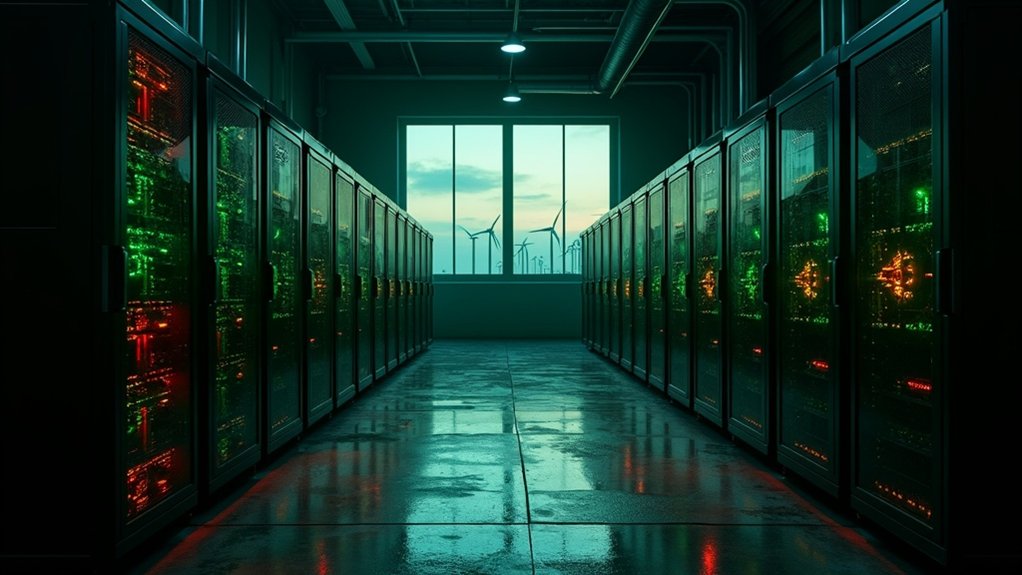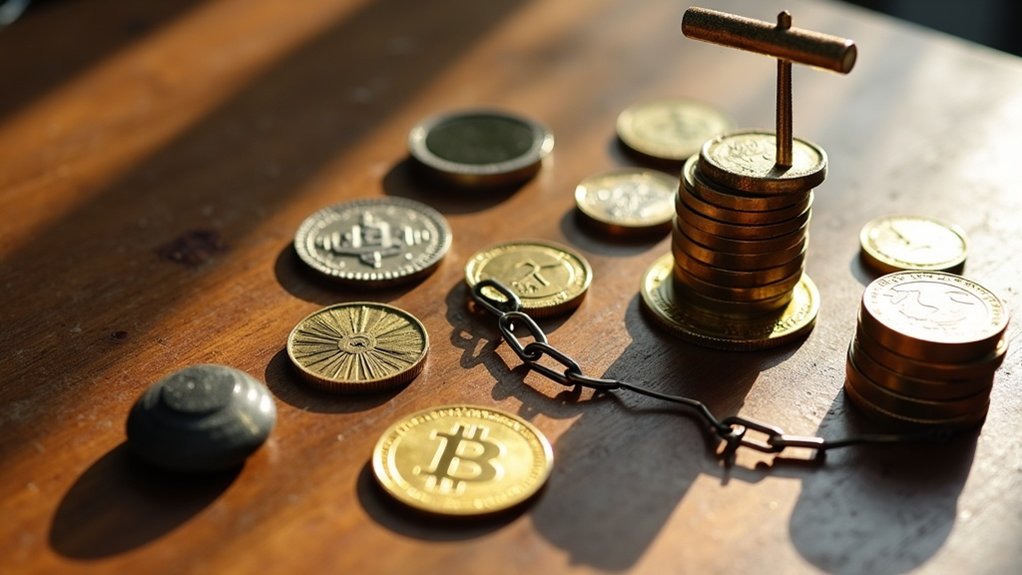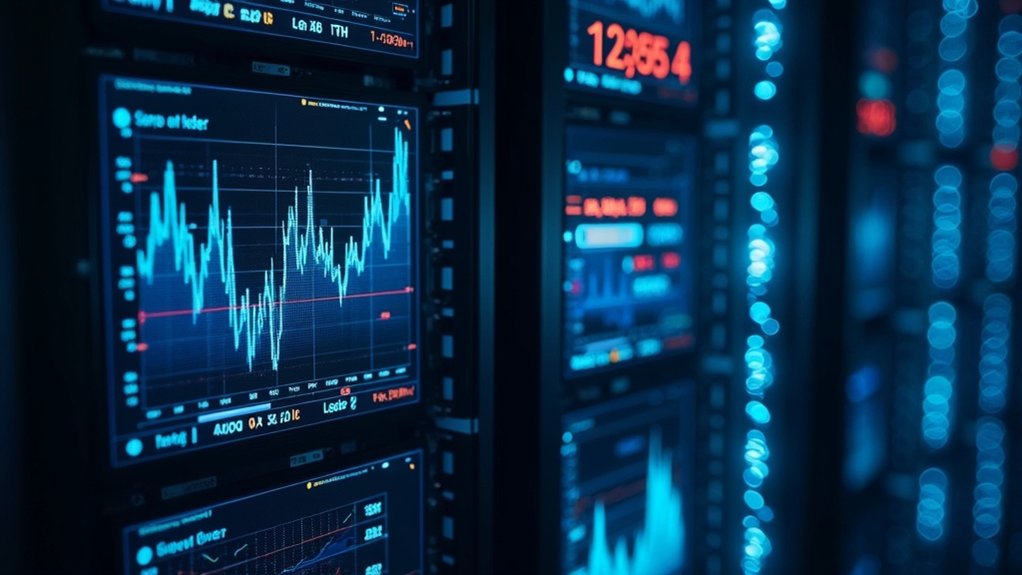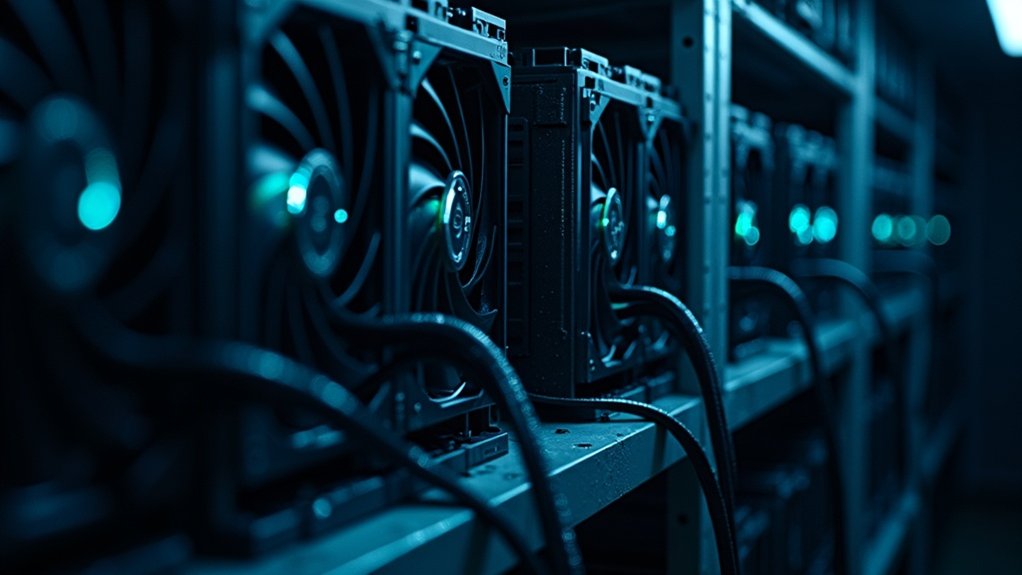Bitcoin mining remains profitable, but it’s no walk in the park. The industry generates $20 million daily despite profitability dropping 7% from last year. Energy costs are the biggest headache. Professional operations dominate with expensive equipment ranging from $2,000 to $20,000 per machine. Hardware efficiency has improved dramatically—from $80 to $16 per terahash. Competition is fierce with network hashrate at 899 exahashes per second. The details reveal a complex profit equation.
How does one actually make money from Bitcoin mining in 2025?
The answer isn’t simple.
Bitcoin mining still generates serious cash—about $20 million daily and $600 million monthly.
Not exactly pocket change.
But profitability has taken a hit, down 7% from last year.
Blame those stubborn energy costs.
The numbers tell the story: miners earn roughly $0.065 per terahash per second (TH/s).
Daily block rewards hit $57,400 per exahash in July—the highest since the last halving, but still 43-50% below pre-halving levels.
That’s the reality.
Mining profitability dances with Bitcoin’s price and network difficulty, which adjusts every couple weeks.
No stability here.
Hardware costs matter.
A lot.
Mining machines run between $2,000 and $20,000 each.
But efficiency has improved dramatically—from $80 per terahash in 2022 to just $16 in 2025.
Next-gen ASIC miners deliver 35% better hash rates than their predecessors.
Progress, people.
The competition?
Brutal.
Network hash rate surged to 899 exahashes per second in July, up 4%.
More miners, more problems.
Network difficulty jumped 9% month-over-month.
Translation: harder to earn the same rewards.
The days of casual mining are dead and buried.
Now it’s all professional operations with scale and technical know-how.
Cloud mining services offer an alternative for those without direct hardware access.
Energy remains the eternal headache.
Bitcoin’s power hunger is legendary.
Smart miners are going renewable—like Norway’s Kryptovault with hydropower.
Some even repurpose excess heat.
Clever.
Electricity prices can make or break operations, which is why Kazakhstan, Russia, and parts of South America remain mining hotspots.
With Bitcoin mining consuming 0.55% of global electricity, the environmental impact can’t be ignored.
The current block reward sits at 3.125 BTC per block.
Not what it used to be, thanks to halvings.
Another critical challenge looms ahead as rewards will soon decrease to 1.5625 BTC per block after the 2028 halving event.
Mining profitability in 2025?
Yes, it exists—if you’ve got cheap electricity, efficient hardware, and scale.
For everyone else?
Good luck competing with the mining giants who’ve poured billions into this game.
The gold rush days are over.
Mining’s now industrial-scale business.
Frequently Asked Questions
What Environmental Impact Does Bitcoin Mining Have?
Bitcoin mining has severe environmental consequences.
It devours electricity—32.3 terawatt-hours annually in the US alone, with 85% from fossil fuels.
The carbon footprint is staggering: 0.7% of global CO₂ emissions.
It creates health hazards through PM2.5 pollution affecting nearly 2 million Americans.
Mining operations generate noise pollution too.
Sure, some miners use renewables (52%), but that often just shifts the problem elsewhere.
The environmental math isn’t pretty, folks.
Can Bitcoin Mining Damage My Computer Hardware?
Yes, bitcoin mining can absolutely wreck your hardware.
The process generates extreme heat, pushing GPUs and ASICs to their limits around the clock. Components degrade faster.
Power surges and electrical issues? Common and deadly for circuits.
Mining rigs typically last just 1.3-5 years before becoming e-waste.
Regular computers aren’t built for this punishment. Gaming PCs forced into mining duty will burn out faster than you can say “blockchain.”
That’s just physics.
Are There Tax Implications for Bitcoin Mining Profits?
Yes, bitcoin mining comes with serious tax baggage.
The IRS considers mined coins as income—taxable at fair market value when received. Not optional, folks.
Miners must track everything: when coins were mined, their value, and transaction fees.
Business miners can deduct expenses like equipment and electricity; hobby miners? Not so lucky.
And when you eventually sell those mined coins? That’s a capital gains event. Record-keeping nightmare, anyone?
How Loud Are Bitcoin Mining Rigs?
Bitcoin mining rigs are loud.
Really loud.
Most operate between 70-90 decibels—think vacuum cleaner or lawnmower running 24/7.
Not exactly neighbor-friendly.
The noise comes from cooling fans working overtime to prevent overheating.
More hash power means more heat, which means more noise.
Fancy new models?
Still noisy.
Some miners use immersion cooling to quiet things down, but it’s expensive.
Commercial operations stick their equipment in remote locations.
For good reason.
Can I Mine Bitcoin With a Regular Laptop?
Mining Bitcoin with a regular laptop? Technically possible. Realistically pointless.
Laptops lack specialized hardware needed for Bitcoin mining.
Their weak hash rates can’t compete with professional ASIC miners.
The math is brutal – electricity costs exceed potential earnings. Always.
Plus, laptops overheat.
Mining pushes hardware to its limits, and laptop cooling systems just can’t handle it.
Mining Bitcoin in 2024 with a laptop is like bringing a spoon to a bulldozer competition. Not gonna work.









